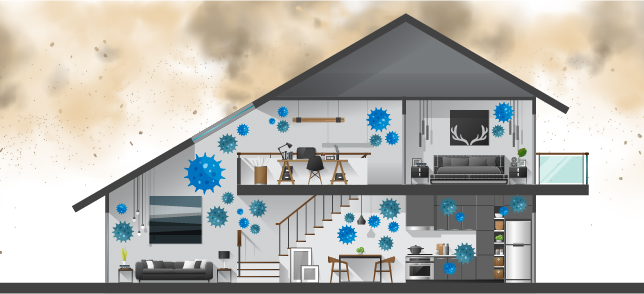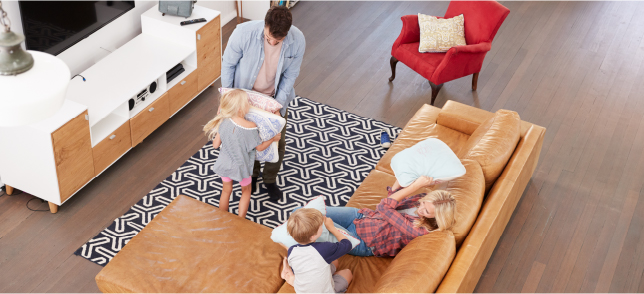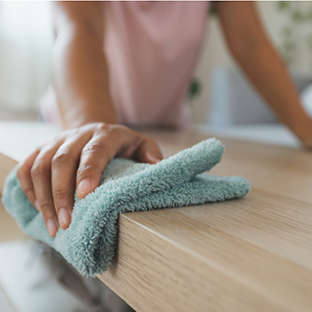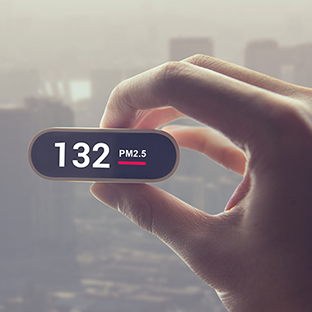How to reduce air pollution and improve
Indoor Air Quality at home
Table of Contents
○ What’s the difference between indoor and outdoor air quality?
○ Why is indoor air quality important?
○ How does indoor air quality affect your health?
○ What is indoor air pollution exactly?
○ What are some indoor air pollutants?
○ Ventilation
○ Filtration
○ Air disinfection
○ Air purification
○ Other ways to prevent poor air quality
Indoor air quality and indoor air pollution
Home should be a place where you can breathe easy.But the air in your home might be doing you more harm than you realise. The air itself can be so polluted that it impacts the health of whoever lives in your home. Indoor air quality is not something we usually think about. We focus on cleaning and disinfecting surfaces, but all the while the very air we breathe at home can be even more polluted than outside air. Luckily there are ways to improve air quality. We’ll get to those in a moment, but first let’s take a look at the facts about air quality at home.
What’s the difference between indoor and outdoor air quality?
Most of us would assume that indoor and outdoor air quality aren’t that different. But you’d be surprised.

Indoor air pollution may be around 100 times higher than outdoor air pollution.*1 As you know, outdoor air can be polluted by things like fossil fuels, cars, factories, mining, or agriculture. While some of those pollutants can come into the house, there are some unique pollutants that live inside the home too.
Why is indoor air quality important?
Indoor air quality is one of the top environmental risks to our wellbeing.*2 We spend at least 80% of our time inside; if we don’t have good-quality air in our homes, we’re making ourselves vulnerable to illness. When looking after our health, we usually focus exclusively on factors such as nutrition and exercise at the expense of environmental factors – at our own risk.
How does indoor air quality affect your health?

Breathing polluted air – inside or outside – is harmful. Poor indoor air quality can affect your health in a number of ways. But it depends on what pollutants are present in your home. And while they can affect everyone, usually those with conditions like respiratory diseases are more vulnerable.*3
Possible health conditions polluted air can cause include:
- Allergic reactions
- Asthma
- Inflammation of the eyes and throat*4
- Headaches
- Dizziness
- Pneumonia
- Reduced lung function*5
- Heart disease
- Increased risk of stroke*6
- Cancer*7
What is indoor air pollution exactly?
It’s air that’s been contaminated by certain particles, chemicals, and gases. And it’s not just polluted air that has come from outside – although that does contribute. A number of different products used inside your home, along with moulds and gases, pollute the air. One of the reasons why air quality can be so poor indoors is because air is prevented from circulating.
What are some indoor air pollutants?
- Radon – A natural radioactive gas that can waft its way from the earth and into the home, radon can cause lung cancer.*8
- Asbestos – A material that was once popularly used when building houses, asbestos leads to lung damage and is a carcinogen.*9
- Volatile organic compounds – This refers to a group of chemicals that are often released by paints and varnishes as well as cleaning and cosmetic products. They can cause eye irritation, headaches, and breathing problems.*10
- Mould – Mould is a natural organism that thrives in damp environments. It releases spores into the air which can give you a runny nose, eye irritation, or make you cough and sneeze.
- Pet dander - These are skin cells that are shed by your pets and can cause an allergic reaction.
- Dust – A mixture of dead skin cells, dead bugs, hair, soil, and fibres – as well as being home to dust mites – dust can cause eye irritation, coughing, sneezing, asthma attacks, and hay fever.*11
- Pesticides – Some bug sprays, disinfectants, and garden products are pesticides, which can cause eye and throat irritation as well as harm your nervous system and kidneys or increase your risk of cancer.*12
- Pollen – Plants release pollen when they reproduce at certain times of the year. It can cause allergies in some people, with symptoms ranging from a runny nose and sneezing to swelling around the eyes.*13
- Viruses and bacteria – These can also pollute the air at home. As you’ll probably know from the COVID-19 pandemic, viruses can contaminate the air and transmit illness – and bacteria can do the same.*14
*1 https://www.healthline.com/health/how-to-improve-air-quality-at-home
*2 https://www.ncbi.nlm.nih.gov/pmc/articles/PMC6125109/
*3 https://www.epa.gov/report-environment/indoor-air-quality
*4 https://filti.com/indoor-vs-outdoor-air-pollution/
*5 https://www.mana.md/indoor-air-vs-outdoor-air/
*6 https://www.blf.org.uk/support-for-you/indoor-air-pollution/about-indoor-air-pollution
*7 https://www.healthline.com/health/how-to-improve-air-quality-at-home
*8 https://www.healthline.com/health/how-to-improve-air-quality-at-home#pollutants
*9 https://www.cancer.gov/about-cancer/causes-prevention/risk/substances/asbestos/asbestos-fact-sheet
*10 https://air.plumelabs.com/learn/en/indoor-outdoor-pollution
*11 https://www.healthywa.wa.gov.au/Articles/F_I/Health-effects-of-dust
*12 https://www.epa.gov/indoor-air-quality-iaq/pesticides-impact-indoor-air-quality
*13 https://aafa.org/allergies/types-of-allergies/pollen-allergy/
*14 https://www.epa.gov/indoor-air-quality-iaq/biological-pollutants-impact-indoor-air-quality
How to improve air quality at home

Knowing that there are so many pollutants floating around your home can be a worry. But don’t fret, as there are a number of steps you can take to protect yourself and your loved ones.
Ventilation
Indoor air quality can be so poor because the air can’t circulate. But you’ll already be familiar with how to improve indoor ventilation: Bring in some fresh air. Open windows and doors to circulate the air and reduce the pollutants in your home. You can also install a ventilation system to make sure air is constantly circulating.
Filtration
Ventilation might not completely get rid of the pollutants, especially if they come from within the home. A filtration system can help. Filters trap pollutants from incoming air, ensuring that the air that passes through is clean. Filters like HEPA (High-Efficiency Particulate Air) filters remove at least 99.95% of particles. Filters can be part of the temperature control system of your home, or you can purchase portable filters that have fans.*15 The important thing to remember is to change your filters regularly. If they get too dirty, they become another source of indoor air pollution.
Air disinfection
Some devices can kill viruses and other microorganisms in the air with ultraviolet light. Certain air purifiers come with this ultraviolet light, but it’s important to note that some UV light wavelengths can be damaging.*16 The UVC wavelength may be the safest option for most people.
Air purification
Air purifiers are devices that clean the air. Most use a form of filtration and some can also disinfect.They usually come with a fan and filters (like HEPA) which bring in contaminated air, remove the pollutants, and blow out purified air. There are many kinds of air purifiers; some are great at removing most (but not all) pollutants from the air while others use UV light to kill viruses.
Other ways to prevent poor air quality
- Plants – A few species of plants kept indoors are natural air purifiers. But you need to ensure you have the right ones, as some may cause allergies. The best options to use are peace lilies, common ivy, and plants belonging to the Dracaena family.
- Keep your home dry – Pollutants like mould love damp environments, so it’s good practice to use a dehumidifier or to keep the house ventilated to make sure it stays dry.
- Clean – Regularly clean your home to keep dust and other pollutants at bay. Make sure to use non-toxic cleaning products that don’t release volatile organic compounds which make the situation worse.*17 Vacuum around the home and change bedding too.
*15 https://www.thisoldhouse.com/green-home/21014891/whole-house-air-purifier
*16 https://www.scientificamerican.com/article/we-need-to-improve-indoor-air-quality-here-rsquo-s-how-and-why/
*17 https://www.healthline.com/health/how-to-improve-air-quality-at-home#pollutants
Life with better air quality
Life with better air quality means life with greater comfort and wellbeing. Your home should be a safe space where you can relax and know that you’re protected. Most of these methods can help you improve the air quality of your home, but they do have their limitations. Some of them can also take a lot of effort. But there’s another simple and powerful way to create a healthy home where you can breathe easy.
nanoe™ X improves indoor air quality
While many filter air purifiers can remove pollutants from the air, many can’t remove them from surfaces – where viruses, bacteria, mould, and pollen can linger. nanoe™ X cleans the air and surfaces. It doesn’t just filter pollutants, but inhibits them through hydroxyl radicals. These natural reactive molecules are known as nature’s detergent. With nanoe™ X you don’t have to worry about the air quality at home. It’s taken care of for you, creating a safe haven where you can truly relax. Now that’s what a home should be.








